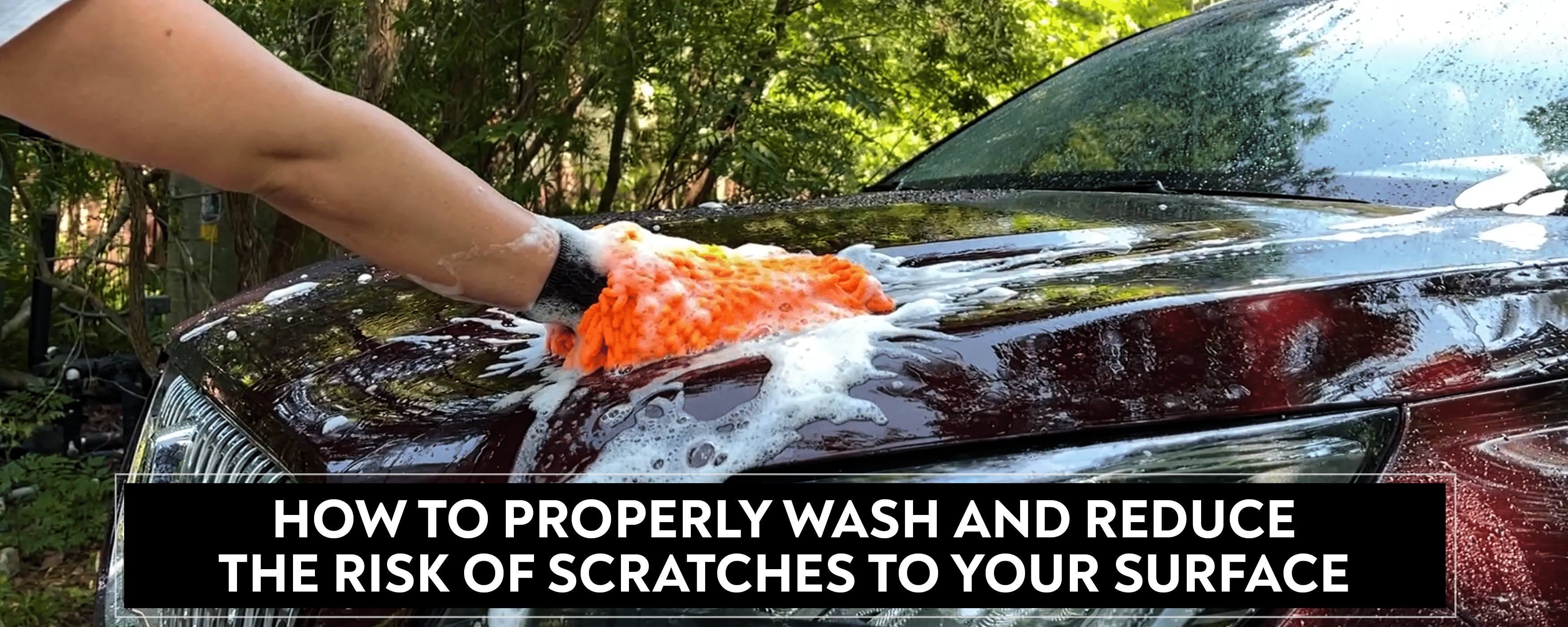FREE US SHIPPING ON ORDERS $75+ (LOWER 48 STATES)
FREE DETAILING ADVICE +1-877-838-2672

Often enough, car enthusiasts witness others improperly washing their vehicle, not due to carelessness but because they don’t know the proper techniques to avoid causing damage to their paint and clearcoat surface.
It has been estimated that about 64% of Americans believe that the appearance of their vehicle is important but only 15% of them take the necessary steps to properly wash and care for the exterior of the vehicle with a reoccurring wash. Unfortunately, many of the people who wash their car by hand end up doing it the wrong way.
Here’s how you can learn how to properly wash your vehicle to ultimately reduce the risk of scratching or damaging the paint and clearcoat surface.
Note: As a basic rule and principle to washing your vehicle, always work from the top down. By working from the top down you will help ensure that debris or dirt is not reapplied to large surfaces as gravity works to move unwanted particles to the lower portion of your vehicle as you perform a wash.
Precautions
You will want to minimize the risk of damaging your paint, and you can do so by taking the precaution of first removing sharp or hard objects from your clothing, your hand’s wedding rings, or other jewelry, covering or taping up rivets in clothing and belt buckles.
Preparations and Organization
Having your work area and where you will wash your vehicle prepped will ultimately reduce the time it takes to wash your vehicle and reduce the risk of chemicals, hard water, or direct sunlight doing any damage to the paint. Having a grasp on where all your washing tools, towels, and chemicals are located will help in this effort. You will want to also pick a cool area that is not in the direct sunlight if you can help it. This will help prevent the drying of soap or water on your vehicle potentially causing stubborn water spots and streaks.
Cleaning/Washing
When starting off, it is best to approach a wash with a two-bucket method where one bucket will be used as a rinse water bucket and the other is your soap water bucket. You can read more about why you should use a two-bucket method to wash your vehicle here. Also, a grit guard is a good add-on to include in your buckets to reduce the chance of dirt, grit, or debris making it back onto your washcloth.
We recommend the use of our TopCoat® PolyWash®, use as little as 1oz per gallon of water for a regular wash, and 2oz per gallon if the vehicle is dirtier than usual for your soap bucket.
We also recommend cleaning your wheels first so you can then focus on your paint surface and avoid allowing water to dry on the surface. You can wash your wheels using the TopCoat® PolyWash® in combination with a wheel brush or microfiber sleeve/TopCoat® LuvGluv®. Be sure to rinse each wheel after cleaning and dry them with a microfiber towel. Do not reuse any of the wheel bucket water, soap, or cloths/mitts for any other part of the vehicle.
Remember to pre-clean the surface by removal of any large debris or dirt by either foaming the exterior or spraying it down with a relatively high-pressure spray of water. Here, you may utilize a pressure washer with a 40-degree nozzle or higher but not one with very high pressure or a 0-degree nozzle, which may cause damage to your paint.
Using a TopCoat® Microfiber Towel as a wash cloth or a TopCoat® Microfiber Wash Mitt, ensure that it is saturated with soapy water before touching the surface of the vehicle and never use circular motions. Start with the roof and then windshield, hood, and then the side body panels. Utilize a method to wash small panels of the vehicle instead of covering large surfaces at once. Remember, work from the top down.
As you wash each panel or section, be sure to immerse the used washcloth or mitt into the water bucket and agitate it to get the remaining dirt and debris off the mitt. Then, wring out the cloth before immersing it into the soapy water bucket. Be sure to rinse each section off as you wash it and move quickly and efficiently so water or soap does not dry on the paint.
Rinse your vehicle thoroughly after the wash has been completed with either a wide nozzle attached to your hose or a pressure washer using a wide degree nozzle.
Drying and Protecting Your Vehicle
There are a couple of methods for drying your vehicle to prevent scratching and to help prevent water spots from forming. Here, you will want to again be quick and efficient in your efforts.
You may utilize our TopCoat® Ginormous Microfiber drying towels or you can utilize our microfiber towns in combination with a hand-held blower. If you use a blower, be sure that you prevent the tip of the blower from coming in contact with the paint. Using the blower will help remove water from hidden areas that may seep onto a visible painted surface after drying.
When drying, you can use our TopCoat® F11® or TopCoat® F11PRO® to protect your washed paint surface, which will help keep it cleaner longer. After drying your vehicle, apply TopCoat® F11® on all surfaces to protect your freshly cleaned and washed surfaces. Using TopCoat® F11® or TopCoat® F11PRO® to protect the surface will make your next vehicle wash much easier. Use a clean microfiber towel to wipe down the surfaces where you have applied TopCoat® F11® TopCoat® F11PRO® and buff it in while flipping the microfiber towel for the final buff.
How often your vehicle requires cleaning will vary depending on how well it is protected with TopCoat® F11® or TopCoat® F11PRO® and other uncontrollable factors, such as weather, road debris, and where your vehicle is parked/stored.

We want you to be 100% satisfied with everything you buy from TopCoat. And if you’re not entirely happy with your purchase we will refund your money in full, or exchange the goods. All we ask is that you contact our customer services and then return the products back to us.